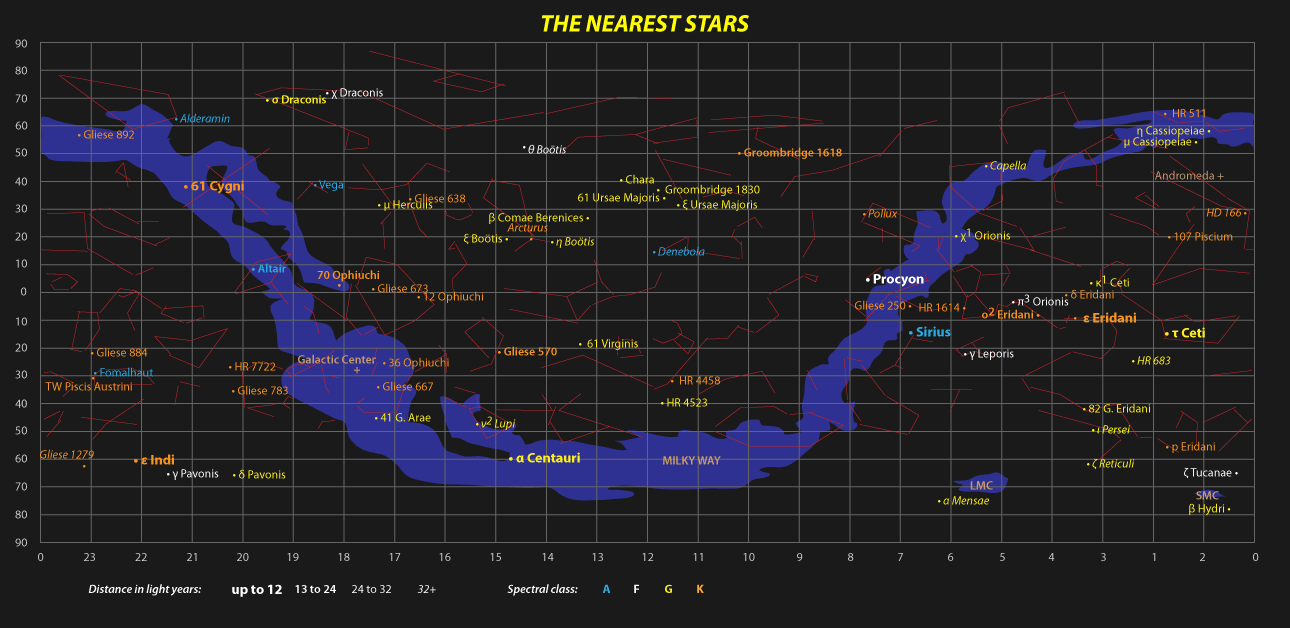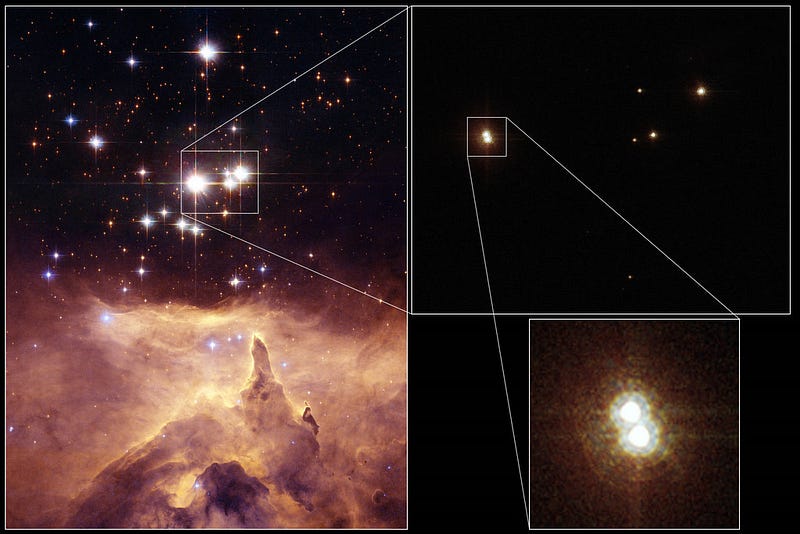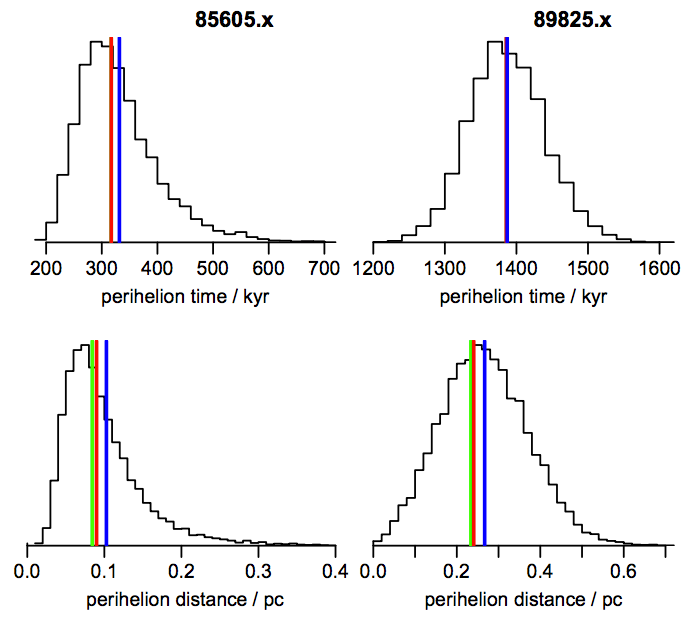Impending Doom
It’s only a matter of time before another star has a close encounter with our Solar System. How long do we have?
“From an incandescent mass we have originated, and into a frozen mass we shall turn. Merciless is the law of nature, and rapidly and irresistibly we are drawn to our doom.” –Nikola Tesla
Our Solar System is a pretty stable place, when you think about it. Like clockwork, the moons orbit the planets, the planets rotate on their axes while orbiting the Sun, and they revolve around the center-of-mass of our Solar System without exception. But don’t forget, there are comets, asteroids, and rogue bodies out beyond Neptune that — every once in a while — get hurled into the inner Solar System, occasionally posing a danger to our lonely planet not too distant from the Sun.

Most of the danger has passed; the asteroids-and-comets that have struck us for the past million years have only been big enough to wipe out a couple of square kilometers, and the rate at which these bodies impact our world is lower than at any point throughout the Solar System’s history.
But there’s something that’s inevitable, that you should find disturbing. In fact, “disturbing” is exactly what’s going to happen, whether you like it or not!

You see, the Sun hurtles through the galaxy, moving in an elliptical orbit. So does our entire Solar System, moving along with it. The part that should make you uncomfortable is that so do hundreds of billions of other stars, and it’s only a matter of time before one of those gets close enough to our Solar System to cause some damage.
As the stars revolve around our galaxy, they don’t simply all move in a simple rotating disk all-at-once, nor do the arms “wind up” over time, but rather stars move in-and-out of the spiral arms in accordance with the density wave theory of galactic rotation. (Video, at right, shows how stars actually move in our galaxy.)
If you want to compute the rate of another star coming colliding with (or coming close to) our Solar System, the formula is very simple. The rate of interaction is simply:
- The number density of stars,
- multiplied by the cross-section of interaction (or how close you care about it coming),
- multiplied by how quickly the stars move relative to one another.
This is an incredibly simple formula, and something we know all about where we are in the galaxy.

In our local neighborhood — some 25-to-28,000 light years from the galactic center — there’s about one star located every 250 cubic light years. You might object and say, “that number’s too big, there are way more stars than that,” but we’ve surveyed the entire solar neighborhood within a radius of 10 parsecs from us (about 32.6 light years), and only found 413 objects.

The cross-section of interaction is an interesting thing. If we want two stars to collide-and-merge, that’s a very rare event, and requires two stars to physically interact, a cross section that’s only about the size of our Sun’s disk. But if all you want to do is disturb the asteroid belt, Kuiper belt or even the Oort cloud, you can pass by our Solar System at a much greater distance and still have an effect. Instead of passing within a few hundred thousand km, you can pass hundreds of millions of km or even — for the Oort cloud — a few trillion km away, and still hurl a great number of objects into the inner Solar System, with potentially catastrophic results.

And finally, the stars all rotate around the galactic center with roughly the same speed: around 220 km/s. But there’s a plus-or-minus to that of about 20 km/s, so that’s the relative speed of the stars to one another.
Put that all together, and what do you find? On average, here’s how often a “bad” event will happen:

- Another star will collide with our Sun, on average, once every 10^20 years. Considering the age of the Universe is only about 13.8 billion years, we’ve got less than a one-in-a-billion chance, every age of the Universe, of having this happen.
- Another star, on the other hand, will pass closer to the asteroid belt than our Sun does, on average, once every 500 trillion years, which means that although the odds of any Sun-like star experiencing this event is low — about 0.003% — there are hundreds of billions of stars in this situation. Of the stars in our galaxy (on average), roughly ten million of them have experienced such a disruptive event.
- Another star will pass closer to the objects of the Kuiper Belt every one trillion years, on average, than the Sun normally is. These disruptions aren’t super common, per se, but each Sun-like solar system has roughly a 1% chance of having this event happen sometime during its lifetime. We seem to have gotten lucky, in this regard, but the Kuiper Belt is still relatively close. If we start to consider the Oort Cloud, things get hairy.

- The Oort cloud, you see, extends for nearly a light-year (or possibly even slightly over one), in theory, in all directions from our Sun. This means — and again, this is on average — we probably get a major disruption of these objects every 500,000-to-2,000,000 years. If you’re wondering where the long-period comets come from, or where catastrophic, life-killing impacts come from, this is a good bet. In fact, whenever a star passes within less than two light-years from our Sun, it’s time to start worrying about what calamities might ensue.
Right now, the closest star system to us is still more than four light-years away.

As you can see, we seem to be safe for the foreseeable future: for at least the next 80,000 years, no star will get close enough to perturb our Oort Cloud in any dangerous sort of fashion. But a little further out, two stars — HIP 85605 and Gliese 710 — may prove to be extraordinarily dangerous.

In a fun recent paper, C.A.L. Bailor-Jones worked out that in roughly 300,000 years, HIP 85605 (shown at left, above) an orange/red dwarf star, may pass within about half-a-light-year from Earth, although the uncertainties on this star’s distance and trajectory are quite large at the present time.
However, another star, Gliese 710 (at right, above), has much smaller uncertainties on it. Despite being very distant now — at about 64 light-years — it’s headed towards Earth and will almost certainly pass within about 1.0 light-years of the Sun, an event expected to happen about 1.4 million years from now. When this occurs, a large number of icy worlds will get thrown into the inner Solar System, creating an incredible phenomenon known as a comet storm.

As fun as this might be, and as glorious a site as it might produce, this offers a tremendous potential for catastrophe. I’m not a fan of plunking down huge amounts of resources into short-term asteroid defense, but this is an event we’ve got to get ready for, long-term.
The next comet storm — although it may be as much as a million+ years off — is going to come, and if we don’t get lucky when it does, it may take all of mammalian life on Earth down with it, similar to an infamous event that happened 65 million years ago.

So while a rogue star isn’t likely to smack into the Sun, or Earth, or any of the worlds in our inner Solar System, our outskirts are often in great danger by a passing star. These massive, icy worlds, forgotten at the edge of the Solar System for billions of years, can make an amazing comeback, becoming fantastic comets and — for the unlucky creatures that are around then — potentially posing tremendous hazards to any inhabited planets.
This might be a once-in-a-million-years event, but the longer humanity sticks around, the more we’re going to have to start prepping for the inevitable. If we don’t, our impending doom is just a matter of time.
Leave your comments at the Starts With A Bang forum on Scienceblogs!





